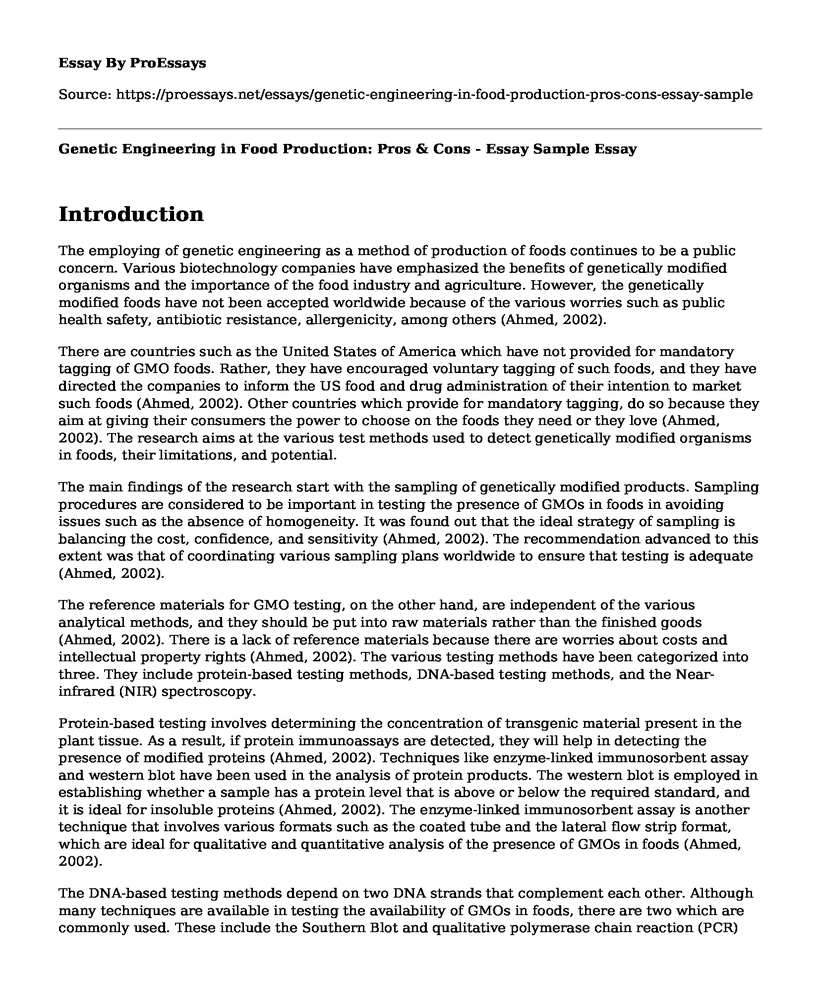Introduction
The employing of genetic engineering as a method of production of foods continues to be a public concern. Various biotechnology companies have emphasized the benefits of genetically modified organisms and the importance of the food industry and agriculture. However, the genetically modified foods have not been accepted worldwide because of the various worries such as public health safety, antibiotic resistance, allergenicity, among others (Ahmed, 2002).
There are countries such as the United States of America which have not provided for mandatory tagging of GMO foods. Rather, they have encouraged voluntary tagging of such foods, and they have directed the companies to inform the US food and drug administration of their intention to market such foods (Ahmed, 2002). Other countries which provide for mandatory tagging, do so because they aim at giving their consumers the power to choose on the foods they need or they love (Ahmed, 2002). The research aims at the various test methods used to detect genetically modified organisms in foods, their limitations, and potential.
The main findings of the research start with the sampling of genetically modified products. Sampling procedures are considered to be important in testing the presence of GMOs in foods in avoiding issues such as the absence of homogeneity. It was found out that the ideal strategy of sampling is balancing the cost, confidence, and sensitivity (Ahmed, 2002). The recommendation advanced to this extent was that of coordinating various sampling plans worldwide to ensure that testing is adequate (Ahmed, 2002).
The reference materials for GMO testing, on the other hand, are independent of the various analytical methods, and they should be put into raw materials rather than the finished goods (Ahmed, 2002). There is a lack of reference materials because there are worries about costs and intellectual property rights (Ahmed, 2002). The various testing methods have been categorized into three. They include protein-based testing methods, DNA-based testing methods, and the Near-infrared (NIR) spectroscopy.
Protein-based testing involves determining the concentration of transgenic material present in the plant tissue. As a result, if protein immunoassays are detected, they will help in detecting the presence of modified proteins (Ahmed, 2002). Techniques like enzyme-linked immunosorbent assay and western blot have been used in the analysis of protein products. The western blot is employed in establishing whether a sample has a protein level that is above or below the required standard, and it is ideal for insoluble proteins (Ahmed, 2002). The enzyme-linked immunosorbent assay is another technique that involves various formats such as the coated tube and the lateral flow strip format, which are ideal for qualitative and quantitative analysis of the presence of GMOs in foods (Ahmed, 2002).
The DNA-based testing methods depend on two DNA strands that complement each other. Although many techniques are available in testing the availability of GMOs in foods, there are two which are commonly used. These include the Southern Blot and qualitative polymerase chain reaction (PCR) (Ahmed, 2002). The southern blot is used in repairing the isolated sample DNA into nylon membranes or nitrocellulose. The qualitative PCR, on the other hand, is used in exploiting the specificity of DNA polymerase to give room for selective amplification of particular DNA portions that occur in low frequencies in a comprehensive mixture (Ahmed, 2002).
Finally, the Near-infrared (NIR) spectroscopy is used by those who handle grain to analyze whole grains to establish whether proteins, moisture, fiber, starch, and oil are present (Ahmed, 2002). The method has been established to be fast, samples are not required, and as such, it is a cheap method. However, the method is not accurate, and it is sensitive to organic compounds (Ahmed, 2002).
Conclusion
In conclusion, the research has contributed to the field of research in immeasurable ways. It has identified the various test methods that can be employed in detecting the presence of genetically modified foods. Further, these test methods have been tried, and their advantages and disadvantages have been identified. To this extent, it will be easier to choose a method that is ideal in testing for the presence of genetically modified organisms in foods.
Reference
Ahmed, F. E. (2002). Detection of genetically modified organisms in foods. TRENDS in Biotechnology, 20(5), 215-223. Doi: 10.1016/S0167-7799(01)01920-5
Cite this page
Genetic Engineering in Food Production: Pros & Cons - Essay Sample. (2023, Aug 03). Retrieved from https://proessays.net/essays/genetic-engineering-in-food-production-pros-cons-essay-sample
If you are the original author of this essay and no longer wish to have it published on the ProEssays website, please click below to request its removal:
- Article Review Exmaple. The Hemispheres of the Brain.
- Literary Analysis Essay on Michael Pollan's The Omnivore's Dilemma
- Nutritional Requirements of Individuals - Essay Sample
- Essay Sample on Poor Eating Habits and Link to Lifestyle Diseases, Including Obesity
- Exploring the Grand Canyon: Nature's Deepest Gorge - Essay Sample
- Paper Example on Include Dietary Fats for Body Energy, Cell Growth, Body Warmth & Nutrient Absorption
- Captive Tigers: An Unsustainable Population in the US - Research Paper







